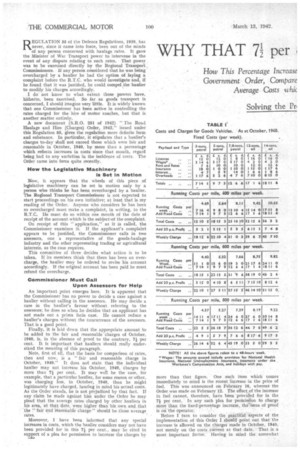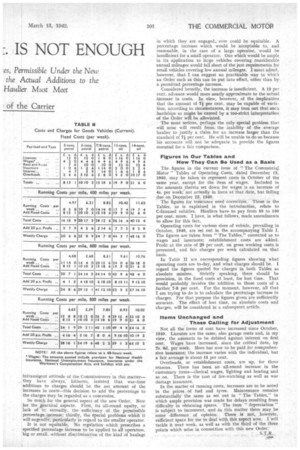WHY THAT 7 per
Page 26

Page 27

If you've noticed an error in this article please click here to report it so we can fix it.
IS NOT ENOUGH
EGULATION 55 of the Defence Regulations, 1039, has nnever, since it came into force, been out of the minds of any person concerned with haulage rates. It gave the Minister of War Transport power to intervene in the event of any dispute relating to such rates. That power was to be exercised directly by the Regional Transport • Commissioners. If any person considered that he was being overcharged by a haulier he had the option of laying a complaint before the R.T.C. who would investigate and, if he found that it was justified, he could compel the haalier to modify his charges accordingly.
I do. not know to what extent those powers have, hitherto, been exercised. So far as goods transport is concerned, I should imagine very little. It is widely known that one Commissioner has been active in controlling the rates charged for the hire of motor coaches, but that is another matter entirely.
A new document (S.R.O. 251 of 1942) "The Road Haulage and Hire (Charges) Order, 1942," issued under this Regulation S. gives the regulation more definite form and substance. In particular, it stipulates that a hauliers charges to-day shall not exceed those which were fair and reasonable in October, 1940, by more than a percentage which reflects increases in costs since that month, regard being had to any variation in the incidence of costs, The Order came into force quite recently.
How the Legislative Machinery is Set in Motion
Now, it appears that the wheels of this piece of legislative machinery can be set in motion only by a person who thinks he has been overcharged by a haulier, The Regional Transport Commissioner is not expected to start proceedings on his own initiative; at least that is my reading of the Order. Anyone who considers he has been so overcharged must make a complaint, in writing, to the R.T.C. He must do so within one month of the date of receipt of the account which is the subjecttof the complaint.
On receipt of this "application," as it is called, the Commissioner examines it. If the applicant's complaint appears to be justified, the Commissioner calls in two assessors, one a representative of the goods-haulage industry and the other representing trading or agricultural interests, as the case requires.
This committee of three decides what action is to be taken. If its members think that there has been an overcharge, the haulier may be ordered to revise his account accordingly. If the original account has been paid he must refund the overcharge.
Commissioner Must Call Upon Assessors for Help An important point emerges here. It is apparent that the Commissioner has no power to decide a case against a haulier without calling in the assessors. He may decide a case in the haulier's favour without referring to the assessors; he does so when he decides that an applicant has not made out a prima facie case. He cannot reduce a haulier's charges .without the concurrence of the assessors. That is a good point.
Finally, it is laid down that the appropriate amount to be added to the fair and reasonable 'charges of October, 1940, is, in the absence of proof to the contrary, 71 per cent. It is important that hauliers should really understand the meaning of this paragraph.
Note, first of all, that the basis for comparison of rates, then and now, is a " fair and reasonable charge in October, 1940." It does not state that the individual haulier may not increase his October, 1940, charges by more than 71 per cent. It may well be the case, for example, that a particular haulier, for some reason or other, was charging less, in October, 1940, than he might legitimately have charged, bearing in mind his actual costs. As the Order stands, he is not prejudiced by that fact. If any claim be made against him under the Order be may plead that the average rates charged by other hauliers in his area, at that date, were higher than his own and that the " fair and reasonable charge " should be those average rates, Moreover, I have been informed that any special increases in costs, which the haulier considers may not have been provided for in this 71 per cent., may be cited in snppert of a plea for permission to increase the charges by more than that figure. One such item which comes immediately to mind is the recent increase in the price of fuel. This was announced on February 16, whereas the Order was made on February 12. The effected the increase in fuel cannot, therefore, have been provided for in the
per cent. In any such plea for permission to charge
• more than the fixed-percentage increase, the -onus of• proof
is ml the operator. • • Before I turn to consider the prac,tical aspects of the implementation of. this Order I should point out that the increase is allowed on the charges made in October, 1940; not merely on the costs current at that date. That is a most important factor. Haying in mind the somewhat intransigent attitude of the Commissioners in this matter— they have always: hitherto, insisted that war-time additions to charges should be the net amount of the increases in costs—this decision to add the percentage to the charges may be regarded as a concession, So mach for the general aspect of the new Order. Now for the practical aspects. First, its all-round equity, or lack of it; secondly, the sufficiency of the permissible percentage increase; thirdly, the special problems which it will engender, particularly in regard to the smaller operator. • It is not equitable. No regulation which prescribes a specified percentage increase to be applied toalt operators, big or small, without discrimination of the kind of haulage in which they are engaged, ever could be equitable. A percentage increase which would be acceptable to, and reasonable, in the case of a large operator, would be insufficient for a small operator. One which would be ample in its application to large vehicles covering considerable annual mileages would fall short of the just requirements for small vehicles covering low annual mileages. I must admit, however, that I can suggest no practicable way in which an Order such as this can be put into effect, other than by a permitted percentage increase.
Considered broadly, the increase is insufficient. A 10 per cent, advance would more nearly approximate to the actual increase in costs. In view, however, of the implication that the amount of 7+ per cent. may be capable of variation, according to circumstances, it may turn out that such hardships as might be caused by a too-strict interpretation of the Order will be alleviated.
The most serious, perhaps the only special problem that will arise will result from, the inability of the average haulier to justify a claim for an increase larger than the standard of 7i• per cent. He will be unable to do so because his accounts will not be adequate to provide the figures essential for a fair comparison.
Figures in Our Tables and How They Can Be Used as a Basis The figures in the current issue of ” The Commercial Motor" Tables of Operating Costs, dated December 13, 1940, may be taken to represent costs in October of the same year, except for the item of wages. Included in the amounts therein set down for wages is an increase of 4s. per week; not actually in force at that date, but falling due on December 23, 1940.
The figures for insurance need correction.' Those in the Tables, as is explained in the introduction, relate to C-licensed vehicles. Hauliers have to pay from 50 to 100 per cent. more. I have, in what follows, made amendments to allow for this fact.
Operating costs for various sties of vehicle, prevailing in October, 1940, are set out in the accompanying Table I. The figures are taken from "The Tables," corrected as to wages and insurance; establishment costs are added. Profit at the rate of 20 per cent, on gross working costs_ is presumed,. and fair charges per week calculated on that basis.
In Table II are corresponding figures showing what operating costs are to-day, and what charges should be. I regard the figures quoted for charges in both Tables as absolute minima. Strictly speaking, there should be provision, in the fixed costs at least, for lost time. That would probably involve the addition to those costs of a further 7-3 per cent. For the moment, however, all that I am trying to do is to calculate the percentage increase in charges. For that purpose the figures given are sufficiently accurate. The effect of lost time, on absolute costs and charges, win be considered in a subsequent article.
Items Unchanged and Those Calling for Adjustment Not all the items of cost have increased since October, 1940. Licences are the same, also garage rents and, in my view, the amounts to be debited against interest on first cost. Wages have increased, since the critical date, by 7s. 6d. per week. More has now to be paid for comprehensive insurance; the increase varies with the individual, but a lair average is about 15 per cent. Overheads, or establishment costs, are up, for three reasons. There has been an all-round increase in the customary items—clerical wages, lighting and heating and so on. There is the cost of fire-watching as well as war damage insurance. In the matter of running costs, increases are to be noted in the prices of fuel and tyres. Maintenance remains substantially the same as set out in " The Tables," in which ample provision was made for delays resulting from difficulty in obtaining spares. The item " depreciation " is subject to increment, and in this matter there may be some difference of opinion. 'There is not, however, suffieient space for me to deal with this aspect now. I will tackle it next week, as well as with the third of the three points which arise in connection with this new Order.




















































